In this installment of the O Scale Freight Car Guide we are taking a different approach to expanding our collective knowledge of O scale freight cars. Rather than focusing on a single type of freight car we are looking at models made for one road name, the Hooker Chemical Company. By taking on a more limited subject we also have an opportunity to share information and create a comprehensive reference for contemporary O scale models of Hooker rolling stock.
Hooker's bright red and orange tank cars were eye catching at a time when most freight cars were drab brown or black. The colorful paint schemes made Hooker freight cars popular with model train manufacturers and model train buyers. That popularity continues today. But what were those tank cars hauling and what types of cars are prototypical? To answer that we first have to understand what Hooker made and how they shipped their products. Let's take a brief look at the History of Hooker Chemical, the products of the Chlor-Alkali process and what type of cars are needed to ship them.
Hooker History
The Hooker Chemical Company was founded by Elon Hooker. Hooker had received a PhD in civil engineering in from Cornell University in 1895 and was appointed Deputy Superintendent of Public Works for the State of New York in 1899 by then Governor Theodore Roosevelt. By 1901 Hooker had left civil engineering to enter what would today be called venture capital. In 1903 Hooker formed his own firm, the Development and Funding Company, to advance promising innovations into commercially viable processes and products. By the end of that year Elon Hooker had become aware of the work of Clinton Townsend and Elmer Sperry on the Townsend Cell and its potential to commercialize the production of basic chemicals from salt water through the use of electricity. By 1905 Hooker had constructed their first plant and became a pioneer in what is now known as the chlor-alkali industry.
The Townsend Cell uses direct electrical current to turn salt water (NaCl and H2O) into chlorine (Cl2), sodium hydroxide (NaOH) and hydrogen (H2). Hooker continued to refine their process with new and more efficient electrolitic cells, created more products from the three basic chemicals and became one of America's leading chemical companies by the mid 20th century.
The first Hooker plant was located in Niagara Falls, New York because of the availability of salt from nearby mines as well as plentiful water and inexpensive hydroelectric power from the Niagara River. Shipment of Hooker's products was by rail. Hooker was not only a shipper but a car owner and lessee. Hooker also contributed early innovations in tank lining to the chemical and rail car industries.
In 1929 Hooker opened a new plant in Tacoma, Washington. The Tacoma plant was located on Commencement Bay and the site offered great economic advantages. Salt was delivered by ship from California and Mexico and unloaded at Hooker's own dock. Tacoma Public Utilities supplied low cost water and electricity. The Tacoma Municipal Belt Line provided rail service to the plant and access to four transcontinental railroads, the GN, Milwaukee, NP and UP. Rail and barge service provided transportation of chemicals to northwest paper mills and California.
After World War II Hooker expanded their product line and added plants through new construction or acquisitions. In 1968 Hooker Chemical was acquired by Occidental Petroleum and became part of their OxyChem chemical division. In the 1970s Hooker gained notoriety for a former disposal site of their waste products, Love Canal. The chemicals involved were not the basic chemicals of the chlor-alkali process but more complex chemicals produced for industry and the government during the WW II era. Love Canal was the subject of much press coverage in the 1970s and even came back to prominence for a moment in the 2000 presidential campaign. For those interested in understanding how the former Hooker disposal site came to have a school and homes built upon it I suggest this concise article at the link below.
http://myamericanodyssey.com/d...about-love-canal-ny/
The Chlor Alkali process
Over the last century Hooker and others continued to develop cell technology to produce higher purity chemicals with greater energy efficiency. The the US Chlor-Alkali industry today leads the developed world in product quality, energy efficiency and environmental protection. Other historic or current North American chlor-alkali producers include BASF, Dow, Georgia Pacific, Olin, Pennsylvania Salt, PPG, Solvay, Stauffer and Wyandotte. All chlor-alkali shippers use similar rail cars and the much of the basic information presented here for Hooker processes and shipping practices applies to other companies in the industry.
Sodium hydroxide, commonly known as caustic soda or lye, is used in a wide variety of industries for a great number of purposes. It has been used for everything from oil refining, pulp and paper making and water treatment to baking pretzels. Sodium Hydroxide can be sold as a dry flake product but is typically shipped in a 50% solution with water. Referred to as “50% caustic” this high concentration solution freezes at about 58 degrees f. Tank cars used in caustic soda service typically hold 8,000 gallons for 50 ton cars and 16,000 gallons for modern 100 ton cars. They are non-pressurized, insulated and equipped with steam lines for heating and thawing the product.
Chlorine is a gas that is cooled and compressed into a liquid for storage and shipment. Chlorine is highly reactive, a quality that makes it very useful as well as extremely hazardous. Chlorine is used for bleaching paper, drinking water purification and the disinfection of waste water. It is also used to make other more complex chemicals including PVC plastics. Chlorine is shipped in pressurized tank cars. In the 50 ton car era chlorine was shipped in 11,000 gallon tank cars. Since the 1960s chlorine tank cars have been built to allow for the shipment of 90 tons of chlorine when loaded to 263,000 pounds gross weight.
Hooker used the hydrogen from their process to make other basic chemicals. Originally the hydrogen was a waste product. But by combining hydrogen with nitrogen from the air Hooker manufactured anhydrous ammonia. Ammonia can be used as a refrigerant or as a source of nitrogen in fertilizer. Anhydrous ammonia is shipped in pressurized tank cars. In the late steam and early diesel era 11,000 gallon tank cars were used but could not be loaded to maximum weight. Since the 1960s large 33,0000 gallon tank cars have been used to haul anhydrous ammonia.
Combining hydrogen with chlorine and water produces hydrochloric acid, also known as muriatic acid. It has a wide variety of industrial uses. Muriatic acid ships in non-pressurized tank cars.
Several of the more exotic compounds produced by Hooker members of the perchlorate family of chemicals. Ammonium perchlorate is used as the oxidizing component in solid rocket engines. Large quantities of ammonium perchlorate were produced in the 1960s in support of military and civilian rocketry including the Minuteman and Polaris missile programs.
O Scale Hooker Freight Cars by Manufacturer
The following is, to the best of my knowledge, a complete list of O scale Hooker freight cars produced since the 1990s. In addition to product numbers I have included road numbers and the commodities shown on the decoration of the car if known. If you are aware of any omissions please let us know what cars need to be added to this list. And if you have any of the cars listed here and can fill in unknown road numbers or commodities please share that information as well.
Atlas
11,000 Gal tank cars
1st run Oct 2003 Tacoma, Wash. Anhydrous Ammonia
8203-1 SHPX 1271
8203-2 SHPX 1290
8203-3 SHPX 1292
8203-4 SHPX 1288

Special for Petersen Supply made over multiple production runs. Chlorine
8214-1 Tacoma, Wash. SHPX 3336
8214-2 Tacoma, Wash. SHPX 3337
8214-3 Niagara Falls, N.Y. SHPX 7421
8214-4 Niagara Falls, N.Y. SHPX 7422
8214-5 Tacoma, Wash. HOKX 711
8214-6 Niagara Falls, N.Y. SHPX 7424*
*Three two rail 9214-6 cars were produced by factory error numbered SHPX 7424 and lettered Tacoma, Wash.

3rd run April 2005 Niagara Falls
8216-1
8216-2
8216-3
8216-4

5th run Sept 2007 Black, Orange
8224-1 SHPX 1284
8224-2 SHPX 1285


7th run august 2010 Niagara Falls
8216-5
8216-6
8216-7
8216-8
8th Run May 2011 Montague, Mich
8240-1
8240-2

17,360 gal/90 ton chlorine tank cars
1st run Oct 2004 orange
8254-1 HCPX 1262
8254-2 HCPX 1264
8254-3 HCPX 1265
8254-4 HCPX 1268

2nd Run June 2005 Occidental
8257-1 HOKX
8257-2 HOKX
8257-3 HOKX
8257-4 HOKX

3rd Run Dec 2007 Occidental, Hooker
8263-1 HOKX 132503
8263-2 HOKX 132589

8264-1 ACFX 85400
8264-2 ACFX 85440

3 Bay covered hopper June 2009 Columbus Miss
6323-1 NAHX 32035
6323-2 NAHX

K-Line
K2630-27 Plymouth switcher 2005
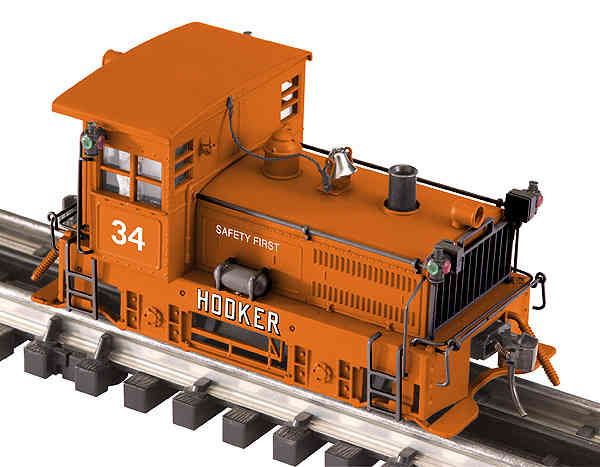
K626-8026 Diecast 4 bay hopper 4 road numbers
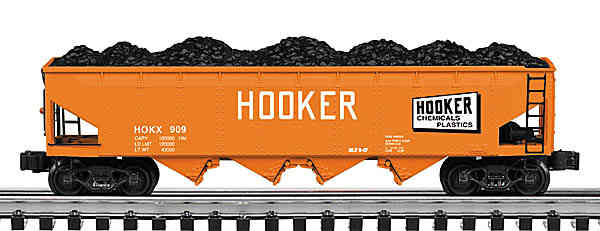
K6341-8011 Tacoma Wash aluminum tank car Chlorine
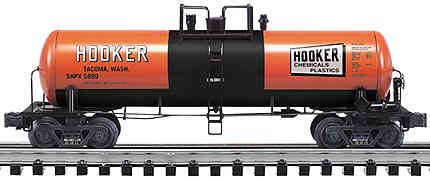
K6341-8016A Aluminum Tank Car 4-Pac 2004
SHPX 13969 Jeffersonville, Ind
SHPX 14556 Columbus, Mississippi Sodium Chlorate
HOKX 56660
SHPX 5941 Montague, Michigan
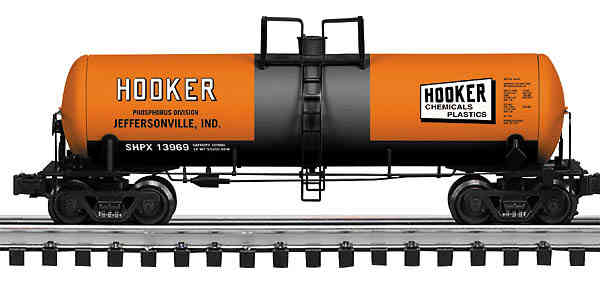
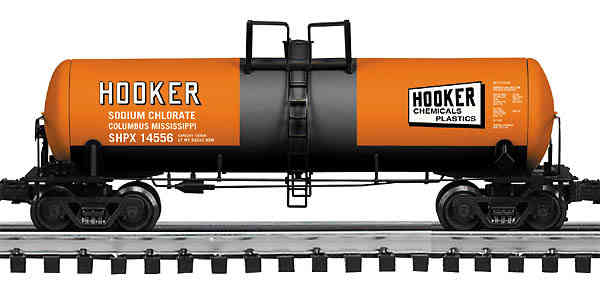
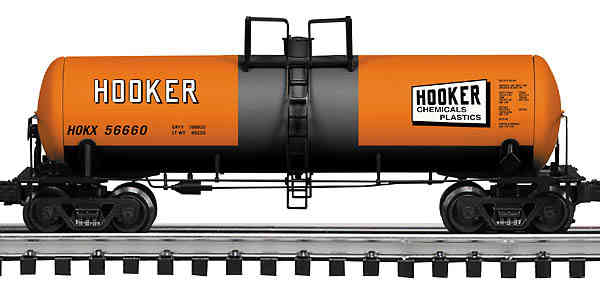
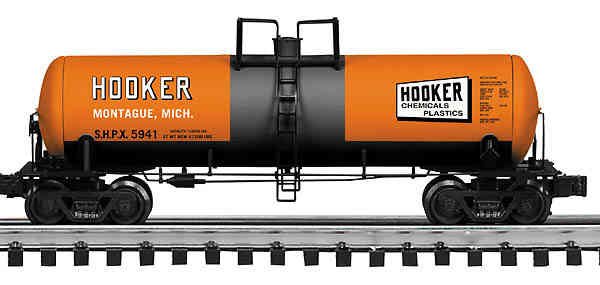
Lionel
6-17909 Uni-body tank car Tacoma Wash GATX 17909 Ammonia 1996
6-19636 Niagara Falls SHPX 19636 caustic soda 2001 Volume 2

6-37977 Wreck scene Niagara Falls SHPX 37977 caustic soda

MTH
20-96008 Tacoma, Wash SHPX 5867 1998 volume 3

20-96187 Montague, Mich. SHPX 9545, 9548 2009 volume 2

20-96221 RTMX 2060, 2063 2012 volume 1 Muriatic Acid

MTH has produced several Hooker freight cars in the rail king line including a modern box car, cylindrical hopper and modern tank car. The Rail King 8000 gallon hooker car is worthy of notice from modelers due to its scale proportions.
30-7342 Tacoma, Wash. GATX 24055 Ammonia 2001 volume 2

Weaver
U1307LD Niagara Falls HOKX 41309

I hope that everyone has enjoyed this look at one road name. Next month we will return to our usual format with an overview of the scale models of one type of car.
For information on other types of freight cars see the O Scale Freight Car Guide thread here.






